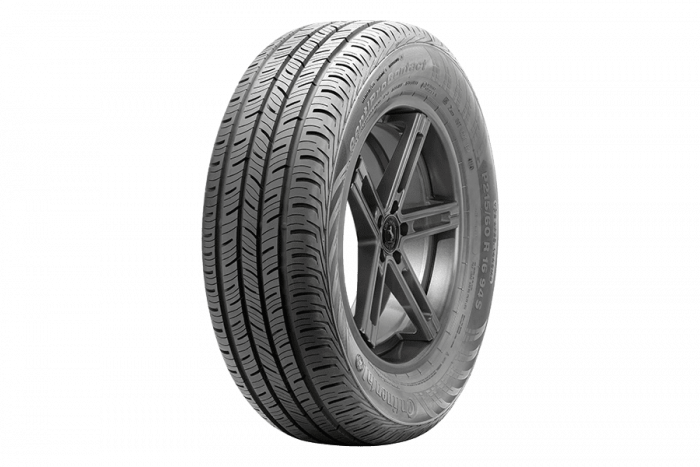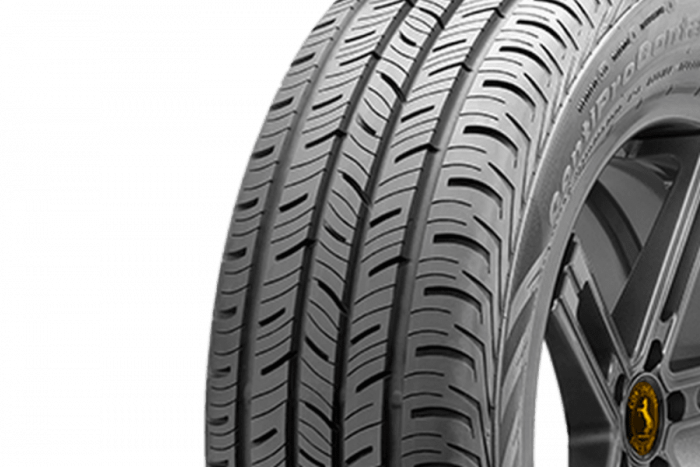ContiProContact is one of the many all-season tire options Continental released in the recent years. Their A/S tires are usually quite costly, but it’s the other way around with CPC. These treads are less expensive than usual and can range from 70 to 115 dollars apiece.
So, if you’re looking for a more affordable but still well-made tire, ContiProContact might be one of the candidates. That said, they aren’t as rich with innovative solutions as their costlier counterparts. They still handle very well, but there are certain problems you’ll notice soon enough.
How is it made?
The composition is pretty standard for the tire-making business. The core is made from two steel belts covered in nylon, which is ultimately a sturdy and strong combination that gives some initial durability.
There are no special additives, like silica and other materials designed to improve performance. Instead, the treads are made from what looks like usual polyester. It can’t be anything fancy, as the tread life isn’t too lasting. Continental gives a mileage warranty of 100,000 to 130,000 km (depending on the tire size), but the real numbers are lower.
In fact, they can be as low as 25,000 to 40,000 km. The expected 100,000 can be reached, but you’ll likely have to drive extra-safely and exclusively in mild weather, which defeats the point.
Tread features
These tires might not be amongst the most lasting, but at least they perform well under most weather conditions.
The pattern is asymmetric, which is often the sign of an optimized tread. It’s easier to make a symmetric pattern that behaves decently enough in most conditions, but for non-symmetric ones they had to put in extra work.
The contact patch is severely reduced because of the four wide circumferential grooves all over the tread. It could potentially deteriorate the handling, traction and steering, but it’s not the case here.
But even now you can see that this tire is bound to be at least alright in wet, owing to the four big grooves around the tread. They are there to help evacuate water from underneath the tires. To improve the wet traction even more, there are countless interlocking sipes spread throughout the tread.

Sipes help with evacuating water somewhat, but they exist mostly for the bite – to improve traction on slippery and snowy surfaces.
Moreover, the shoulder areas are rife with various big and small grooves (including sipes) that together improve the handling in most challenging scenarios – from snow to mud to slush. It’s called a ‘ProActiveEdge’ technology, and it works wonders.
And don’t forget about the three central ribs. The two on the sides provide ample steering and grip as they are, but they’ve also given the same treatment to the middle rib. There are tons of sipes and grooves designed to increase performance even further. Usually, this section is booked for a wide and stable contact area, but Continental decided to instead give their central rib a more aggressive design.
Comfort
ContiProContact tires usually handle well and ride smooth, which means a lot if you know you’ll have to go over some challenging environment. Even though it’s optimal to use them on highways and safe roads, you can’t escape the nature. Well, you won’t really feel uncomfortable with these on.
On another hand, they produce a lot of noise. These treads are positively roaring even in calm situations. And if you somehow got into mud (which you shouldn’t have done), there’ll be a whole orchestra.
Final thoughts
Continental ContiProContact might not be the best investment, considering they get spent fast and produce a lot of noise. Nevertheless, the characteristics that affect the driving performance directly are excellent. It’s likely you won’t regret buying them.
Although, it’s important to note that driving them through awful roads will deteriorate them fast. Choose better roads if you can and don’t buy them if you expect rough weather conditions where you live.
Tire Sizes
15″
155/60 R 15
165/60 R 15
175/55 R 15
175/65 R 15
185/55 R 15
195/50 R 15
195/65 R 15
195/65 R 15
195/65 R 15
P185/65 R 15
P195/65 R 15
P195/65 R 15
P205/65 R 15
16″
195/45 R 16
195/55 R 16
205/55 R 16
205/55 R 16
205/55 R 16
205/55 R 16
205/65 R 16
215/55 R 16
215/55 R 16
215/60 R 16
225/55 R 16
P 205/55 R 16
P 205/60 R 16
P 205/70 R 16
P 215/60 R 16
P195/55 R 16
P205/55 R 16
P205/55 R 16
P215/70 R 16
17″
205/45 R 17
205/50 R 17
205/50 R 17
205/50 R 17
205/55 R 17
215/50 R 17
215/50 R 17
215/55 R 17
225/45 R 17
225/45 R 17
225/45 R 17
225/45 R 17
225/45 R 17
225/45 R 17
225/45 R 17
225/50 R 17
225/50 R 17
225/55 R 17
225/55 R 17
225/55 R 17
235/45 R 17
235/45 R 17
235/45 R 17
235/45 R 17
235/45 R 17
235/45 R 17
235/55 R 17
235/55 R 17
245/40 R 17
245/45 R 17
245/45 R 17
245/45 R 17
255/40 R 17
P 215/45 R 17
P 215/55 R 17
P 225/50 R 17
P 235/65 R 17
P225/60 R 17
18″
225/40 R 18
225/40 R 18
225/45 R 18
225/45 R 18
225/50 R 18
235/40 R 18
235/40 R 18
235/40 R 18
235/45 R 18
235/50 R 18
235/50 R 18
235/55 R 18
245/40 R 18
245/40 R 18
245/40 R 18
245/40 R 18
245/45 R 18
245/45 R 18
245/45 R 18
245/45 R 18
255/35 R 18
255/40 R 18
255/45 R 18
255/45 R 18
265/35 R 18
275/45 R 18
285/35 R 18
P 225/60 R 18
P215/55 R 18
P235/45 R 18
19″
235/40 R 19
235/40 R 19
235/45 R 19
245/40 R 19
245/45 R 19
255/40 R 19
255/40 R 19
255/45 R 19
255/45 R 19
275/40 R 19
275/40 R 19
285/40 R 19
P 235/45 R 19
P245/45 R 19
P275/40 R 19





